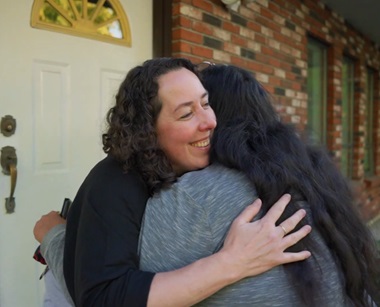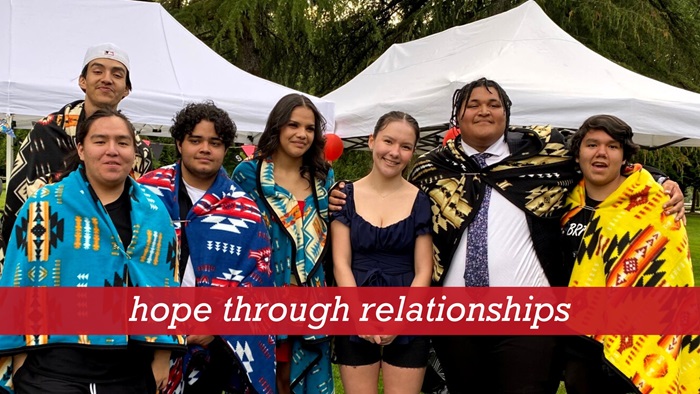
Jenny Shantz has been welcoming neighbours in east Vancouver for more than two decades.
Jenny Shantz spends her days with youth and their families in East Vancouver who have been impacted by intergenerational trauma, “nurturing hope, belonging and growth.”
She sent this message to supporters of Inner Hope Youth Ministries April 4.
Last month, I was driving with a couple of residents from Inner Hope’s home and we began discussing money management. I broached the topic of RRSPs and suggested to them that opening up a retirement savings account in their 20’s would help them have the resources they need when they are older.
One of them responded, “but we’re probably not going to live past 65 anyways”.
Last week, I was with another young adult who got into the seat beside me and immediately started listing all the young people he knew who had died in the past year: friends, his best friend’s brother, a cousin and his own brother. This is the current reality among the youth and families we journey with.
Seven year drop
In both British Columbia and Alberta, reports have been released over the last few months highlighting a drop in life expectancy of at least seven years among Indigenous people between 2015 – 2021.
In BC, the First Nations Health Authority released a report stating that life expectancy dropped by 7.1 years.
In Alberta, over the same period, the life expectancy for Indigenous men dropped from 67 to 60, and from Indigenous women from 73 to 66 years. In 2021, non-Indigenous men in Alberta live to be 79 and non-Indigenous women lived to be 84 (a life expectancy gap of almost two decades).
How do we have a life expectancy among Indigenous people in BC and Alberta that is most often seen in the Third World or war-torn countries?
The biggest contributing factor in both provinces is the toxic drug supply. Colonization and residential schools continue to have a devastating impact and many turn to drugs to numb the pain of extensive trauma.
Other factors include family breakdown, the high representation in the foster care system and systemic barriers to accessing health care and homelessness. In 2023, 39 percent of those homeless in greater Vancouver (1,005 people) were Indigenous. 67 percent of Indigenous people who were homeless were impacted by residential schools, either themselves, a parent or a grandparent.
Systemic barriers
When it comes to systems, some people wonder what a systemic barrier looks like.
On February 24, the 31 year old brother of a past resident died of pneumonia.
It was a huge example of systemic barriers. He was born and raised in BC, but attended a treatment centre in a different province and his health coverage was moved to Saskatchewan. When he returned to BC a few years ago, he struggled to complete the paperwork to get his health care coverage moved back to BC.
Although Canada prides itself on universal health care and we are supposed to be able to access primary health care when in a different province, he was repeatedly told that he didn’t have coverage and would have to pay out of pocket. Bills for hospital visits totalling over $50,000 were sent to his mom’s house; they even texted his phone weekly for collection.
The week he developed pneumonia, he was hoping it was just a bad cold and he would get better on his own. His mom and sister are confident that his rising stack of health bills impacted how long he waited to access care. Unfortunately, he delayed seeking help until he was struggling to breath. He went into hospital at 6 pm on Friday and was dead by 11:35 am on Saturday. A doctor told the family that if he had come in sooner, he would have survived.
On top of the trauma of his death, his mom was called by the hospital two days later and was informed that if she couldn’t arrange for BC health coverage she was now responsible for a $17,000 bill because she was the next of kin. He leaves behind two children.

Death in a group home
In a different situation, I continue to advocate for changes in BC’s foster care system. As of January 2024, 68 percent of children in foster care in BC were Indigenous. Often foster care placements do not meet their needs.
In the fall of 2020, a 17 year old boy died in a group home in Abbotsford and was dead in his room for four-and-a-half days before he was found.
The group home he lived in had locks on the kitchen cupboard to limit access to food and sometimes locked residents out of the home if staff left on an errand. That group home company operates 10 group homes in Abbotsford and Mission.
A relative reached out to me and asked me to support the mom after the youth’s death. My time spent with the mother and advocating on her behalf has led to a request that I be a witness in an upcoming Human Rights Tribunal. I have been told that I will likely be on the stand at least a full day.
The parties to the case are: The Ministry of Children and Families for BC, Xyólheméylh (Fraser Valley Aboriginal Child and Family Services), the Abbotsford Police Department, Reese Family Services (which ran the group home) and the Coroner of BC.
The tribunal starts on April 29 and will last a few weeks. Prayers are appreciated as I will likely be cross examined by 10-plus lawyers representing these organizations and I will need strength and clarity.
Jenny Shantz is Executive Director of Inner Hope Youth Ministries. She has spent more than 20 years befriending Indigenous youth and families, mainly on the east side of Vancouver.
